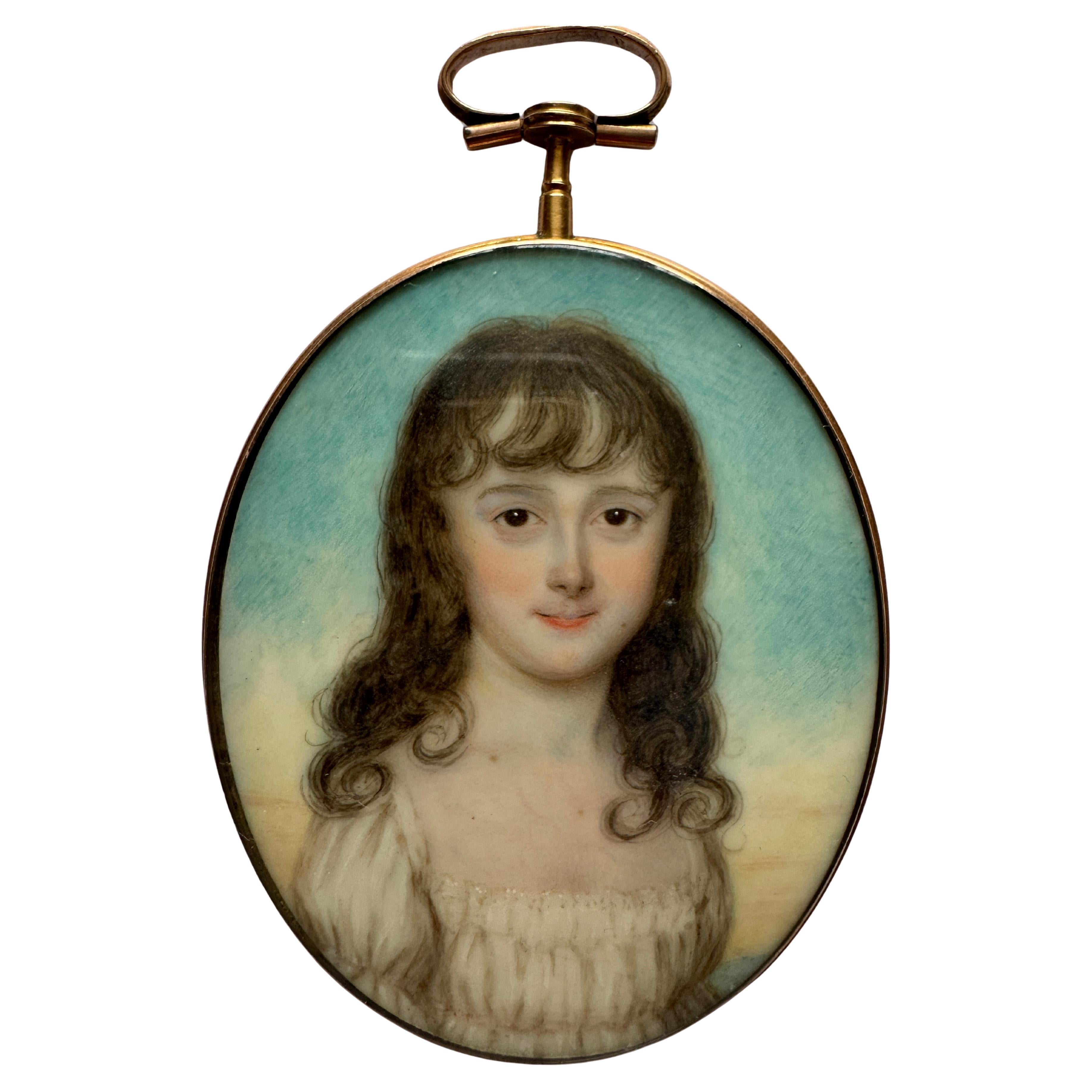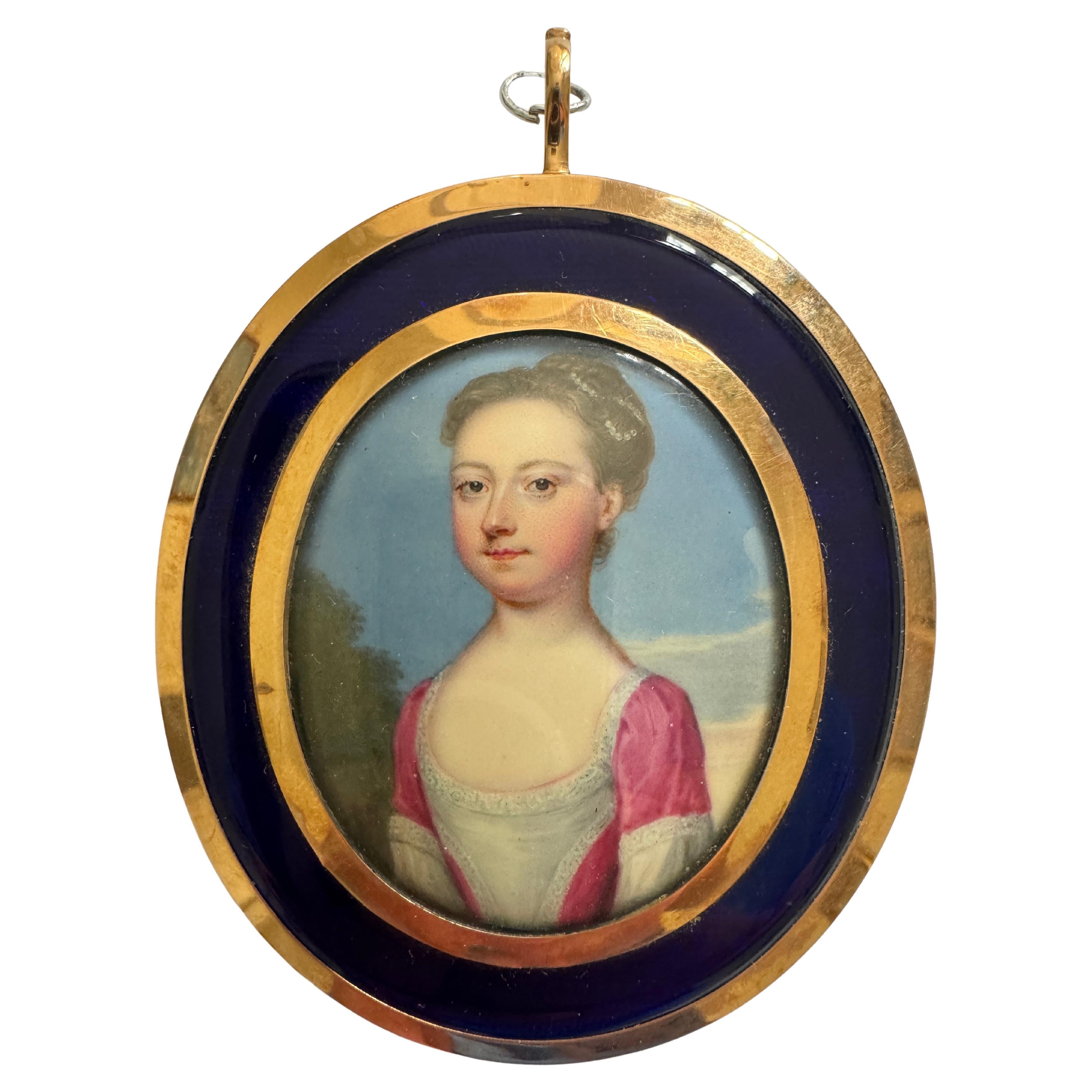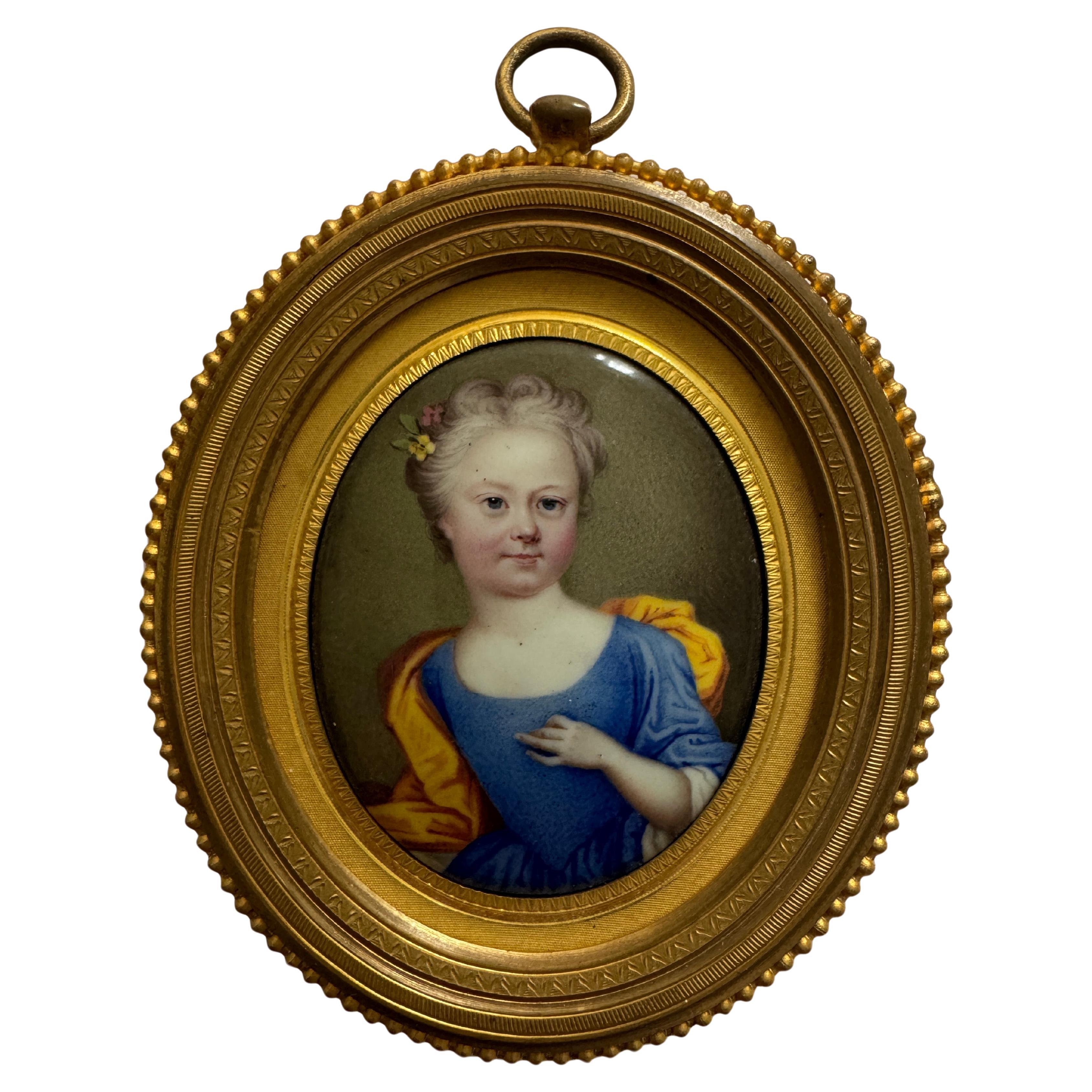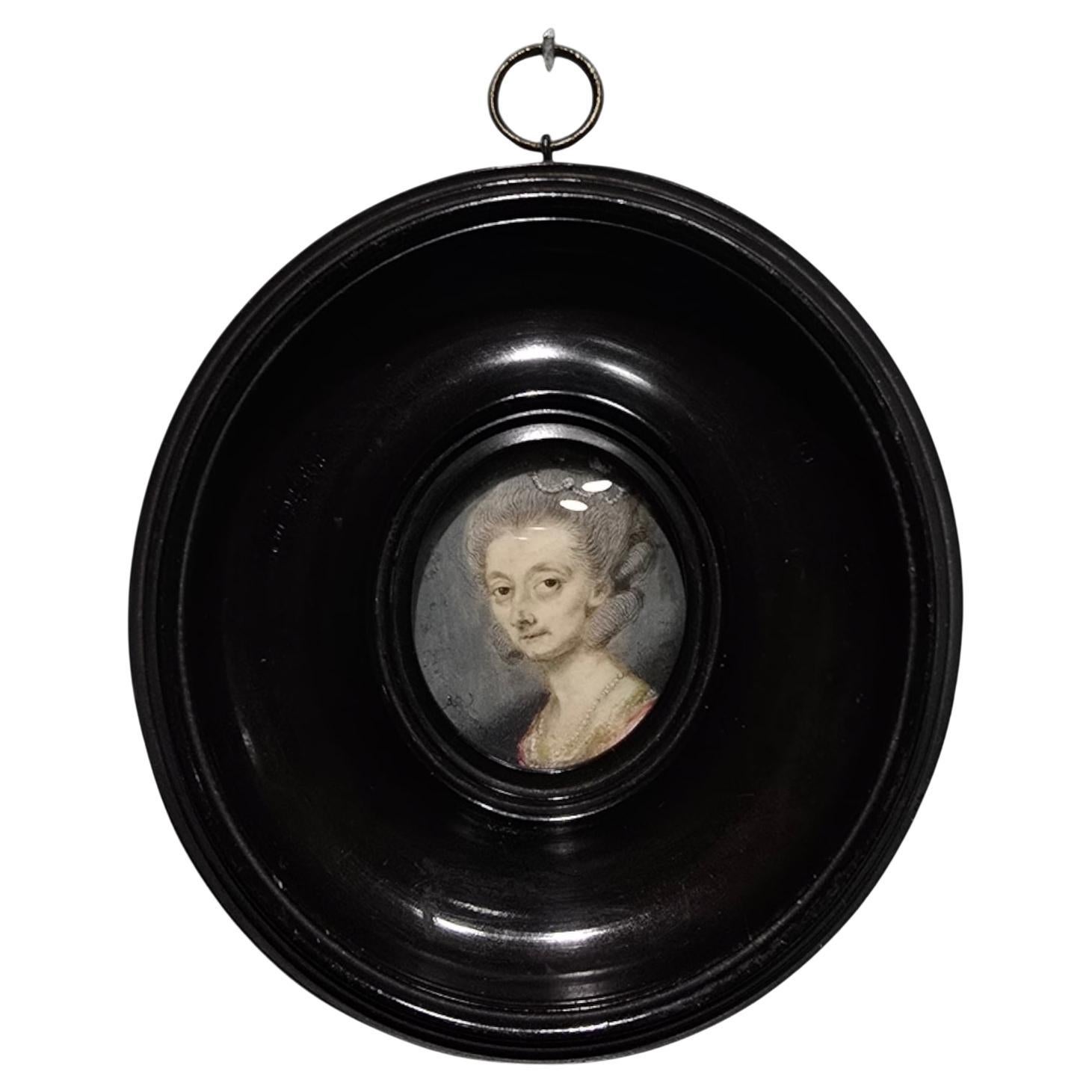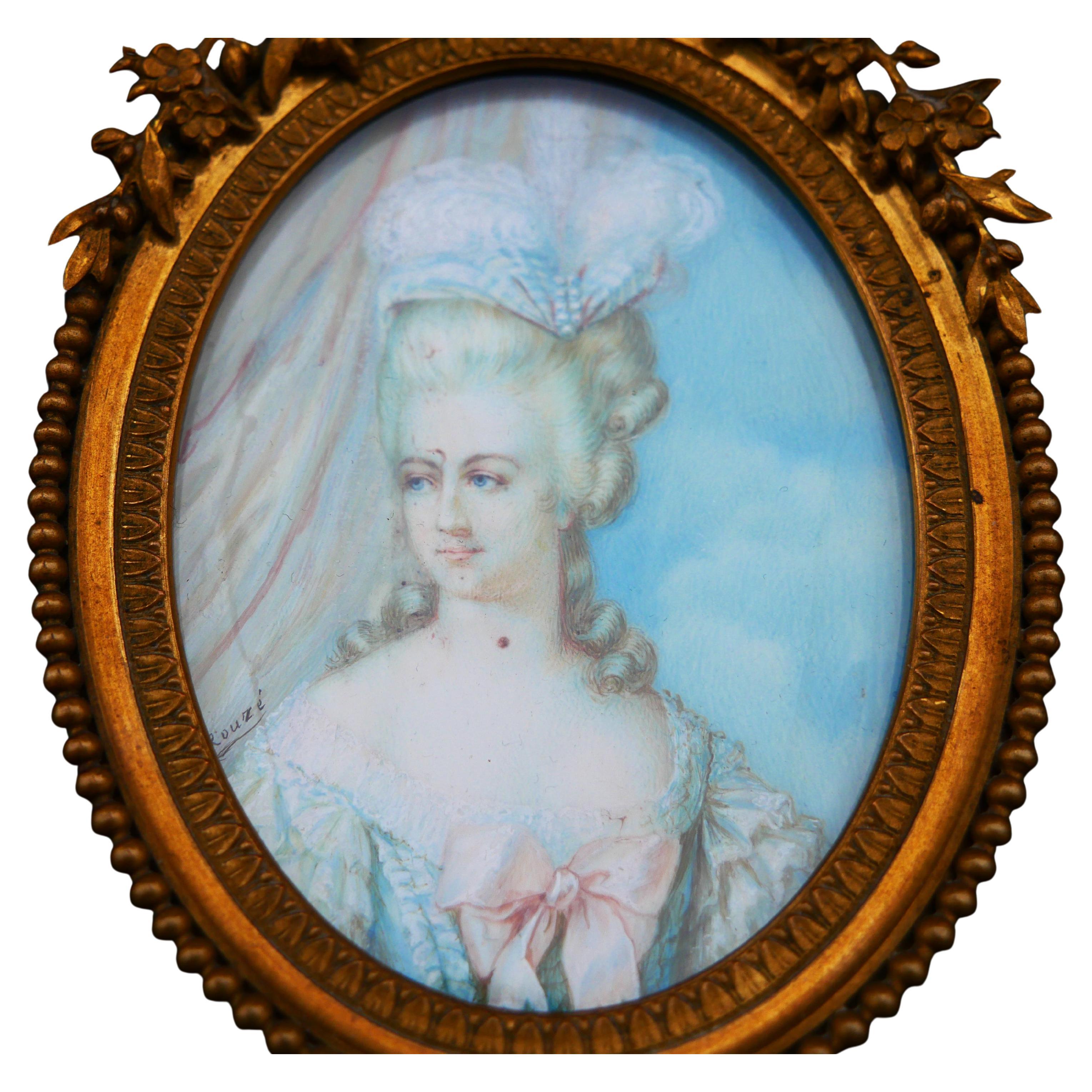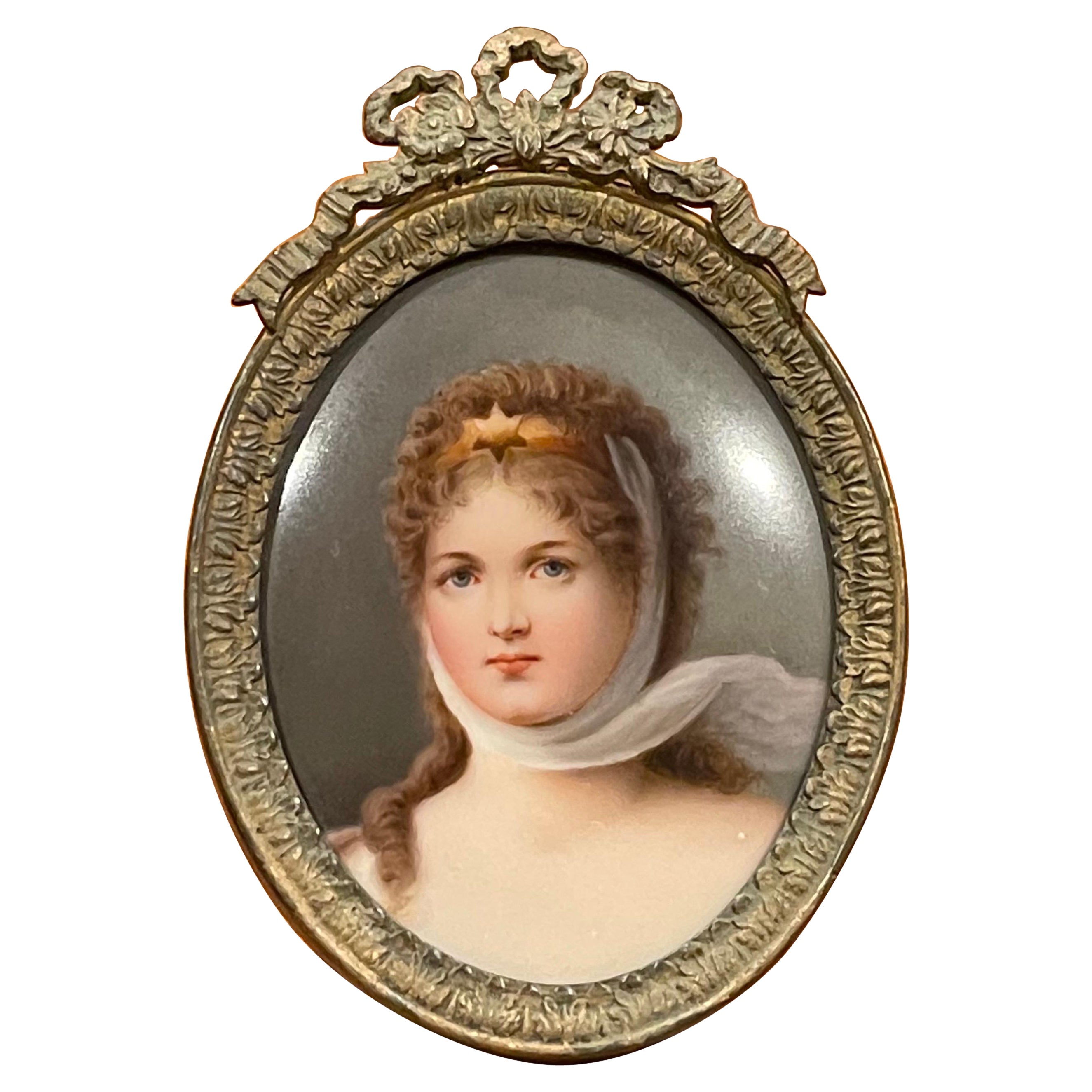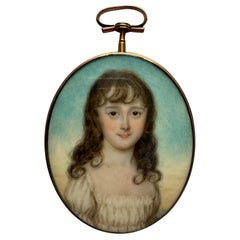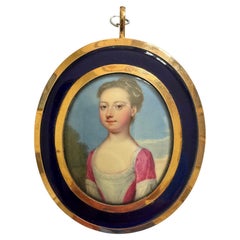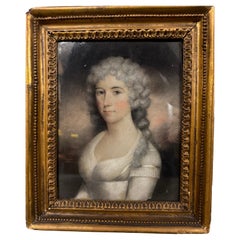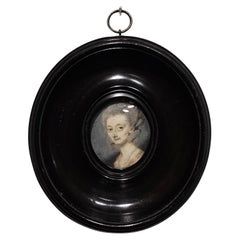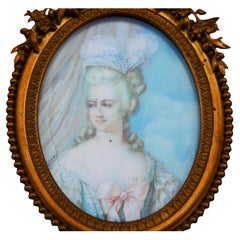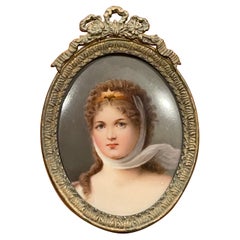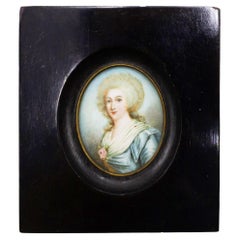Items Similar to 18th Century Portrait Miniature Attributed to George Engleheart (1750 -1829)
Want more images or videos?
Request additional images or videos from the seller
1 of 10
18th Century Portrait Miniature Attributed to George Engleheart (1750 -1829)
$8,271.67
£6,000
€7,006.47
CA$11,437.05
A$12,556.46
CHF 6,550.73
MX$151,950.61
NOK 82,103.24
SEK 77,362.84
DKK 52,301.46
About the Item
18th Century Portrait Miniature Attributed to George Engleheart (1750 - 1829) , Portrait of a young lady, bust length, her powdered hair adorned with pearls and wearing a white dress with a ruffled collar watercolour. Oval 6.5cm / 2.5" inches. In a gold frame with a hair plait and guilloche back.
UK Ivory registration number: 2U3VVX3J
Engleheart is generally thought to have been born in Kew, Surrey, on 26 October 1750. His father was Francis Englehart (died 1773), a German plaster modeller who emigrated to England as a child; his mother was Anne Dawney. He had seven brothers. The family name was changed to Engleheart after his father died.
He married his first wife, Elizabeth Brown, in 1776; and the couple set up house in Prince's Street, Hanover Square, London. Elizabeth died in April 1779, aged only 26. Engleheart moved to 4 Hertford Street in Mayfair, London. He married his second wife, Ursula Sarah Browne in 1785; and the couple had four children: George, Nathaniel, Harry and Emma.
In 1813, Engleheart retired full-time to his country house in Bedfont, near Hounslow in Middlesex. He had built the house on land he purchased in 1783, and the interiors are said to have been decorated in the fashionable neo-classical style of Robert Adam. His second wife, Ursula, died in 1817, and Engleheart soon after gave up the house and went to live with his son Nathaniel in Blackheath, then a village to the southeast of London.
Engleheart died in Blackheath on 21 March 1829, and was buried at St. Anne's Church, Kew.
His nephew, John Cox Dillman Engleheart, was also an accomplished portrait miniaturist, painting during the Regency era.
Engleheart entered the newly formed Royal Academy Schools on 3 November 1769. He was a pupil of George Barret, R.A., and of Sir Joshua Reynolds. Engleheart started on his own account in 1773, and worked mainly in London for the whole of his career. He regularly exhibited at the Royal Academy from 1773 to 1822. He kept a detailed fee book from 1775 to 1813, which included detailed sketches of his miniatures. The book remains in the possession of his family to this day. Engleheart was a prolific artist: during the period of 39 years covered by the fee book, no less than 4,853 miniatures are recorded as having been executed by him.
His fees ranged from 3 guineas in 1775, up to 25 guineas by 1811. His professional income for many years exceeded £1,200 per annum.
Engleheart mainly painted watercolour on ivory, and his work can be categorised into three distinct periods.
His initial paintings were small in size. It was common for artists of the period circa 1775 to paint on small ivories of approximately 1½ to 2 inches in height. Miniaturists at this time were still learning to exploit the full potential of ivory, and were struggling to find ways of adhering the watercolour to its greasy surface. Hence, they found it difficult to paint large areas of ivory, and tended to keep the miniatures small. It was still fashionable for ladies to wear portrait miniatures on bracelets around their wrists, and small miniatures helped facilitate this. Engleheart's portraits of this era are sometimes signed 'G.E.' The flesh tones are coloured by reddish tints over a pale ground, with the facial features accentuated using a bluish-grey tone.
During the period circa 1780–1795, Engleheart developed his very distinctive style, with his draughtsmanship and use of colour becoming consistent and high quality. He still sometimes paints small sized miniatures, but he more frequently paints on ivories of around 2½ inches in height. His works are easily recognisable: he often portrays his sitters with deep eyes under strong eyebrows, together with a slightly lengthened nose, and the flesh colour of the face is painted using a brownish yellow tone. The corners of the mouth are drawn with diagonal grey strokes. Engleheart imbues his sitters with a sense of gentleness, elegance and serenity; even his military officers look more at home in the drawing room than the battlefield. He often used opaque white to pick out the details of the pale coloured dresses worn by his female subjects, and their hair is often worn high and/or powdered, as was the fashion of the time. The men wear their hair powdered 'en queue', i.e. powdered wigs worn over long hair pulled back into a ponytail which was tied with a black ribbon. Engleheart did not always sign his work during this period, but towards the end of this phase he began signing with a cursive 'E' placed in the bottom corner of the obverse, and he continued with this style of signature for quite a number of years. In addition, he also started to sign and date his portraits in full on their reverse.
The third and final period of Engleheart's career is circa 1795–1813. His painting style does not really change from that developed in the preceding years, but his ivories are now large, measuring around 3 to 3½ inches in height. The clothes of his sitters are much simpler, following the simple style which came into fashion in France from 1789 onwards, as a result of the Revolution. Powdered hair was further helped out of fashion in Britain in 1795, when the British government imposed a tax of 1 guinea per annum on those individuals wishing to wear hair powder or powdered wigs; the tax being introduced to part finance the war with France (it was during the French Revolutionary Wars). The fashions of this era are referred to as the Regency style. Men tended to dress like country squires: often wearing a plain navy blue or brown coat, with a white high-collared shirt and white cravat; their hair was brushed forward (imitating the style worn by the ancient Romans) and sometimes markedly pushed up vertically off the forehead. Women dressed in the Grecian style, wearing empire line dresses in white muslin or coloured silk or satin; their hair is worn up, with longer curls falling either side of the face as the period progressed. During this time, Engleheart tutored two of his relatives, John Cox Dillman Engleheart and Thomas Richmond, in how to paint miniatures. As this final phase of his career progressed, Engleheart reverted to signing his work with a 'G.E.', in either cursive form or block capitals.
Engleheart painted George III twenty-five times, and had a very extensive circle of patrons, comprising nearly all the important persons connected with the court. He made careful copies in miniature of many of the famous paintings executed by Sir Joshua Reynolds, and in some cases these constitute the only information we possess respecting portraits by Sir Joshua that are now missing. His fee-book, colours, appliances and a large collection of his miniatures still remain in the possession of his descendants
- Dimensions:Height: 2.56 in (6.5 cm)Width: 2.17 in (5.5 cm)Depth: 0.08 in (2 mm)
- Style:Rococo (Of the Period)
- Materials and Techniques:
- Place of Origin:
- Period:1780-1789
- Date of Manufacture:circa 1780
- Condition:Wear consistent with age and use. Minor fading.
- Seller Location:Basildon, GB
- Reference Number:Seller: 80031stDibs: LU8971246151032
About the Seller
5.0
Vetted Professional Seller
Every seller passes strict standards for authenticity and reliability
Established in 2021
1stDibs seller since 2023
20 sales on 1stDibs
Typical response time: 1 hour
- ShippingRetrieving quote...Shipping from: Basildon, United Kingdom
- Return Policy
Authenticity Guarantee
In the unlikely event there’s an issue with an item’s authenticity, contact us within 1 year for a full refund. DetailsMoney-Back Guarantee
If your item is not as described, is damaged in transit, or does not arrive, contact us within 7 days for a full refund. Details24-Hour Cancellation
You have a 24-hour grace period in which to reconsider your purchase, with no questions asked.Vetted Professional Sellers
Our world-class sellers must adhere to strict standards for service and quality, maintaining the integrity of our listings.Price-Match Guarantee
If you find that a seller listed the same item for a lower price elsewhere, we’ll match it.Trusted Global Delivery
Our best-in-class carrier network provides specialized shipping options worldwide, including custom delivery.More From This Seller
View All18th Century Portrait Miniature - Style of William Wood (1768 -1809)
Located in Basildon, GB
18th Century Portrait Miniature - Style of William Wood (1768 -1809) , A young girl, bust length, with long curling brown hair and wearing a white dress, sky background. Watercolour....
Category
Antique Late 18th Century English Rococo Paintings
Materials
Gold
18th Century Portrait Miniature Attributed to Christian Friedrich Zincke
Located in Basildon, GB
18th Century Portrait Miniature Attributed to Christian Friedrich Zincke (1683 - 1767)
A young girl, possibly a relative to Charlote Tilson, Lady Deane (b 1918), half length, her ha...
Category
Antique 1730s English Rococo Paintings
Materials
Gold, Copper, Enamel
18th Century Portrait Miniature of a Child
Located in Basildon, GB
18th Century Portrait Miniature of a Child, in the style of Christian Friedrich Zincke, half length, her hair adorned with flowers and wearing a blue dress with a yellow cape enamel ...
Category
Antique 1730s English Rococo Paintings
Materials
Copper, Enamel
18th Century Portrait of a Lady
By (circle of) Thomas Gainsborough
Located in Basildon, GB
18th Century Head and Shoulders Portrait of a Lady, English School in the manner of Thomas Gainsborough, in old gilt wood frame with new back panel and glass.
Category
Antique Late 17th Century English Georgian Paintings
Materials
Paint
18th Century British School, Portrait of Lady and Child
Located in Basildon, GB
18th Century British School, Portrait of Lady and Child, oil painted on board in a naïve style, framed in a gold coloured frame.
Partial old handwritten note on the back of the pai...
Category
Antique 18th Century English Folk Art Paintings
Materials
Wood, Oak
Pair of 18th Century English School Portraits of Children
Located in Basildon, GB
Pair of 18th Century English School Portraits of Children, by a follower of Francis Alleyne, framed in an ornate, oval-shaped gold and dark-coloured frames. One portrait of a young ...
Category
Antique 18th Century English Rococo Paintings
Materials
Canvas
You May Also Like
18th-Century Miniature Oil Painting – Possibly England
Located in Madrid, ES
18th-Century Miniature Oil Painting – Possibly England
Exquisite 18th-century miniature oil painting, likely of English origin, featuring delicate brushwork and fine detail.
Medium:...
Category
Antique 1740s Paintings
Materials
Fruitwood
Antique Marie Antuanette Miniature Portrait Tempera Painting
Located in Malmö, SE
Fine hand-painted depiction of Marie Antoinette, wife of French King Louis XVI, the last Queen of France before the French Revolution.
This painting dates ca. 19th century, very lik...
Category
Antique 1880s French Louis XVI Decorative Art
Materials
Gold, Bronze
Antique Hand Painted Miniature Portrait on Porcelain in a Brass Easel Frame
Located in San Diego, CA
A very nice antique hand-painted miniature portrait on porcelain of Princess Louise of England, circa 1900s. The piece is mostly likely a "Grand Tour" ...
Category
Early 20th Century French French Provincial Paintings
Materials
Brass
$800 Sale Price
20% Off
19th Century French Victorian Miniature Framed Watercolor Portrait
Located in Queens, NY
Late 19th Century French Victorian oval miniature watercolor on vellum portrait of a woman with a light blue dress in an ebonized frame.
Category
Antique Late 19th Century French Victorian Paintings
Materials
Wood
18th-Century Miniature Oil Portrait
Located in Madrid, ES
18th-Century Miniature Oil Portrait
Fine miniature portrait depicting a gentleman from the late 17th century, dressed in period attire.
Medium...
Category
Antique 1740s Paintings
Materials
Silver
18th Century Reverse Painted Image on Glass in a Gilt Frame
Located in Los Angeles, CA
A wonderful reverse painted glass image. The image of a 17th C. female is wonderfully done and in very nice colors. The Frame is gilt and the image sits back, creating a shadow affec...
Category
Antique 18th Century European Paintings
Materials
Giltwood, Paint
More Ways To Browse
Dress Worn By
Pearl Hair
Grecian Dress
Gold Portrait Miniature
White Ruffle Dress
Muslin Dress
Mens Bracelets For Small Wrists
Antique Regency Dress
Empire Library
Flame Maple
Flower Vanity
Folk Art Rabbit
Francois Linke Commode
French Cherub Mantel Clock
French Hanging Cabinet
French Indochina
Fretwork Gallery
George I Walnut Chest Of Drawers
